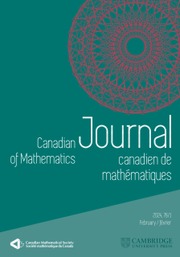Article contents
The Pseudo-Orbit Shadowing Property for Markov Operators in the Space of Probability Density Functions
Published online by Cambridge University Press: 20 November 2018
Abstract
Let X be a space with two metrics d1 and d2. Let S :(X, d1 ) → (X, d 2) be continuous. We say S has the generalized pseudoorbit shadowing property with respect to the metrics d 1 and d 2 if for every  every δ-pseudo-orbit in d1 can be ∊-shadowed by a true orbit in d 2, i.e., if {x 0, x 1,…} satisfies
every δ-pseudo-orbit in d1 can be ∊-shadowed by a true orbit in d 2, i.e., if {x 0, x 1,…} satisfies  for all i ≧ 0, then
for all i ≧ 0, then  for all i ≧ 0. The main result of this note shows that certain Markov operators P : L1→ L1 have the generalized shadowing property on weakly compact subsets of the space of probability density functions, where d 1 is the metric of norm convergence and d 2 is the metric of weak convergence. An important class of such operators are the Frobenius-Perron operators induced by certain expanding and nonexpanding maps on the interval. When there is exponential convergence of the iterates to the density, we can express δ in terms of ∊. We also show that, unlike the situation in the space X itself, the generalized shadowing property is valid for all parameters in families of maps and that there is stability of the shadowing property.
for all i ≧ 0. The main result of this note shows that certain Markov operators P : L1→ L1 have the generalized shadowing property on weakly compact subsets of the space of probability density functions, where d 1 is the metric of norm convergence and d 2 is the metric of weak convergence. An important class of such operators are the Frobenius-Perron operators induced by certain expanding and nonexpanding maps on the interval. When there is exponential convergence of the iterates to the density, we can express δ in terms of ∊. We also show that, unlike the situation in the space X itself, the generalized shadowing property is valid for all parameters in families of maps and that there is stability of the shadowing property.
Information
- Type
- Research Article
- Information
- Copyright
- Copyright © Canadian Mathematical Society 1990
Footnotes
This research was supported by a grant from NSERC.
References
- 2
- Cited by

